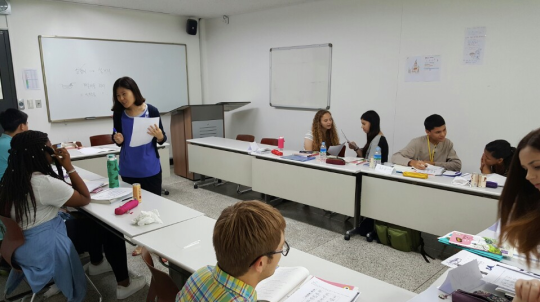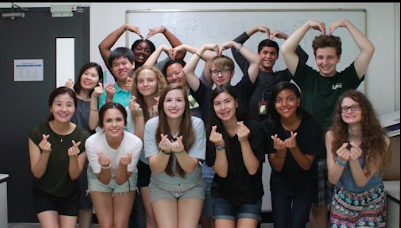Hi everyone! Here’s Part 2 on my “How I Learned Korean” series. In Part 1, I talked about how I self-studied Korean before applying to NSLI-Y. In this post, I’ll talk about how I studied during NSLI-Y, in Seoul. My study methods were very different of course, because during NSLI-Y, I got to have actual classes instead of studying on my own as I had done before. Also, during NSLI-Y, I wanted to utilize being in Seoul and having the opportunity to speak with native speakers as much as possible, so I changed my study methods a bit to include that. I hope you find this post useful!
–Sofia 🙂
- Grammar
In class: We each got a Sookmyung University textbook and would learn new grammar based on our textbook’s curriculum. First, we would go over the new grammar point as a class. We’d practice saying new sentences to each other, and our teacher would usually show us a quick powerpoint. Then, we would do exercises in our textbook. For instance, we might write out new sentences, match up verbs to their correct conjugations, or answer fill-in-the-blank questions.
Outside of class: Each week in class, we’d learn multiple new grammar points. This included learning new verb conjugations, how to use adverbs, and more. To keep track of all of the new grammar-related lessons we learned, I made a flash card for each individual grammar point, and I went over each one at night. Over time, the number of flash cards built up, but it was always manageable because I revised each night so I wouldn’t forget the grammar points we’d learned from a few weeks ago. This was especially useful when we had our midterms and final exams. It’s also been useful post-NSLIY, because if I want to revise what I learned over the summer, I just have to look over my flashcards.

2. Vocabulary
In class: In class, we would learn new vocabulary from our textbook and from our teacher’s powerpoint presentations. We didn’t go over individual words often, because it was expected that we would note down new words and memorize them at home. I actually learned a lot of new vocabulary from answering grammar-related questions.
Outside of class: Vocabulary is a difficult one to talk about because of the insane amount of vocab that we learned over the summer. At first, I tried to make a Quizlet for each new set of vocabulary that we learned. However, we would learn about 30 new vocabulary words every few days, so I just wound up with too many vocab flashcards and Quizlet sets to manage the sheer amount of new words we were learning. In the end, I found it most useful to make a Quizlet set out of the words that I found most difficult to learn.
Don’t worry if you’re not memorizing every single word that you go over in class right away, because I found that just by living in Korea, I didn’t really have to use flashcards very often to force myself to learn new words. I learned a lot of new vocabulary naturally, as I conversed with my host family and other Koreans out in Seoul.
But if I wanted to memorize specific words, I found that it’s really useful to write out sentences using the vocabulary word and also a new grammar point. That way, you can combine studying grammar and vocabulary. Also, the more practice you get using grammar points and vocabulary in actual sentences, the easier it will be to memorize what you’ve learned!
3. Speaking and Listening
In class: The second half of our lessons would always focus on speaking and listening skills. We would often listen to recordings, and then we would answer questions about them on a handout from our teacher. We would also partner up and read out dialogues in our textbook. Each Friday, we would actually have a small test where we would have to memorize the dialogues in our textbook and reenact them. It was a little stressful to have to memorize all of the dialogues for the tests, but they actually did help me learn, so it was okay in the end.

Outside of class: Coming to NSLI-Y, one of my main goals was to practice my speaking and listening skills by exploring Seoul and by conversing with my host family as much as possible. Speaking with my host family was one of my favorite ways to practice speaking, because they were very encouraging and always willing to point out my mistakes and teach me new words.
It’s actually very common to get trapped in a situation where you initially speak English with your host family because you don’t know much Korean when first coming to NSLI-Y, and then it’s awkward switching to speaking Korean weeks later. This happened to me, to an extent, but luckily, the awkward in-between-languages-stage passed quickly. In the end, my host family and I were able to connect better when we got to have conversations in their native language. I learned so much from talking with them, and it was always super exciting to use what I had learned in class in an actual conversation.
Thanks for reading! I’ll be posting Part 3 of this series on “How I Learned Korean: Post-NSLI-Y” soon.


